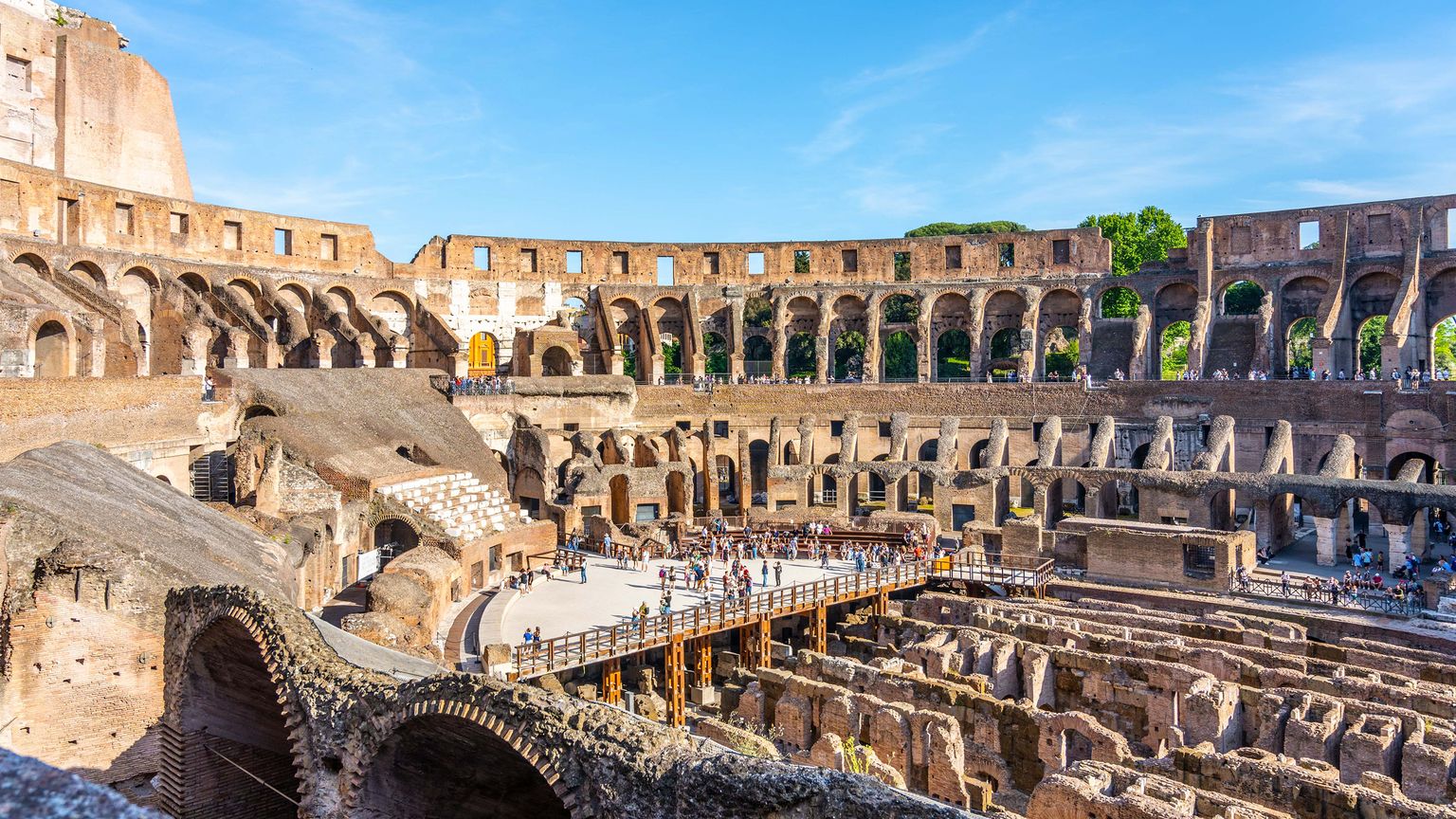
8 Colosseum facts to know before visiting Rome
Is “visit Colosseum” the top item on your bucket list? If you’re dreaming of exploring the world’s largest amphitheater on an Italy tour, here’s some Roman Colosseum history to know before you go.
Historic monuments, winding cobblestone streets, charming cafes—there are so many highlights to admire as you explore Rome. Even with the countless beautiful things in the city, one icon always rises to the top of travelers’ I-can’t-believe-I-saw-that lists: the Roman Colosseum. This ancient amphitheater has spent centuries on Palatine Hill (where Romulus and Remus founded Rome!) and you can practically feel the vibrations of history when you step inside. To make the most of your visit, read on for eight Colosseum facts to know before you go.
1. The Colosseum is famous for being the world’s largest amphitheater
Here’s one of the many fun facts about the Colosseum that will give you a sense of just how impressive the site is: The amphitheater is almost as long as two football fields. At its tallest point, the Colosseum stands 157 feet high—which is around the same height as the Washington Monument. There are four levels to the Colosseum and in ancient Rome, more than 50,000 spectators could enter through the 80 entrances. You’ll hear all about this history when you visit the Colosseum on a tour of Rome.
Want to cap off your Colosseum visit with another iconic site? Here’s everything to know about visiting the Vatican in Rome →

2. Gladiatorial shows took place at the Colosseum
The Colosseum was once a site for gladiatorial duels, where gladiators and wild animals battled each other for the entertainment of the locals. Ancient Romans even received free entry to the events held here, and it was the equivalent to watching a major sporting event today.
One of the more well-known facts about the Roman Colosseum is that many of the gladiators were people who were enslaved. However, a common misconception is that the fights always ended in death, but they usually ended when one person was too injured to continue. This is because the gladiators received special training—those who trained the fighters and promoted the events didn’t like to see their gladiators needlessly die.
Looking for more interesting facts about the Eternal City? Find them in our beginner’s Travel Guide to Rome →
3. The Colosseum is over 1,900 years old
That’s right, this marvel of ancient Roman engineering is almost 2,000 years old. That fact makes it even more amazing that we can still visit the Colosseum today! Ready for more interesting facts about the Colosseum that may surprise you? The amphitheater is more than 1,500 years older than the Taj Mahal in India and more than 500 years older than the Great Wall of China.
What our travelers say: The Colosseum is inextricably tied to Rome’s cityscape, and traveler Simonette perfectly captured the feeling of experiencing all that history. “I loved Rome!” she said. “The fact that you can go pretty much anywhere by walking and run into ancient ruins totally blows my mind. Seeing the city’s architecture, walls, arches, wells, restaurants, and more that are thousands of years old was awesome and surreal! I still have chills just thinking about it.”
Looking for more ancient history? Discover eight of the world’s oldest cities that are trending right now →

4. The Colosseum only took eight years to build
When you look at the grand ruins of the Colosseum (which still include many intact arches, passageways, and seats), you might be surprised to discover that this hulking site was built in record time. The amphitheater’s construction began in 72 A.D. and finished in 80 A.D. It took less than 10 years to craft one of history’s most enduring sites thanks to skilled builders, good funding, ready access to travertine stone, and more. Pretty impressive for one of the world’s most iconic architectural marvels, right?
Get another history fix by checking out 10 fascinating facts about the Pyramids of Giza →
5. It’s one of the New Seven Wonders of the World
Visiting the Colosseum feels like flipping back through the pages of history. This history and the icon’s international admiration earned the Colosseum a place on the list of the New Seven Wonders of the World. Thousands of people voted for the Colosseum to make the list, and the honor was announced on July 7, 2007. Petra in Jordan and Machu Picchu in Peru also pop up on the list, so the Colosseum is certainly in great company.
What our travelers say: “We visited all of the staple places like the Colosseum,” said traveler Paige. “It was all amazing, amazing, amazing. I loved walking down the cobblestone-paved roads, touching places that I’d only heard about in my old high school European history class.”
6. More than 7 million people visit the Colosseum each year
The words “explore Rome” and “visit Colosseum” go hand in hand. When you’re on our guided tours of Rome, you won’t just see the Colosseum—you’ll enter it, too! That will make you one of the millions who flock to this world wonder every year. Lucky for you, you’ll get to skip the lines and enter the Colosseum with your expert local guide and Tour Director. Traveler Lori put it perfectly when she said, “Who wants to waste precious vacation time figuring out how to get to the Colosseum, anyway?” Once you’re inside, you’ll be in awe of the ruins—and your expert guide will share countless fun facts about the Colosseum.
Wondering about the best time to visit Rome? Check our our season-by-season guide to the Eternal City →

7. You can see a section that was once underground
One of the interesting facts about the Colosseum is that Emperor Domitian added a two-level underground section called the hypogeum. Before the addition of the hypogeum, the arena was often flooded to recreate naval battles. After the addition, gladiators and wild animals stayed in this underground section of the arena before fights, and then emerged in front of the crowd thanks to a rope-and-pulley system controlling 80 vertical passageways. Today, the hypogeum is easily viewable and your local guide will paint an even more vivid picture of the sites (and show off all the Roman Colosseum facts they know!) when you join them on our Rome tours.
This amazing history is one of the many reasons why Rome has earned a spot on our must-visit list. Check out the best things to do, see, and eat in our Italy Travel Guide →
8. The Colosseum has withstood multiple earthquakes
The Colosseum has stood the test of time—literally. It’s been shaken by six earthquakes throughout history, and you can spot a diagonal break down the side of the amphitheater when you’re strolling through this ancient site on our tours of Rome. That’s one piece of damage from an earthquake that rocked the site in 1349 A.D. and split the facade. Unlike other amphitheaters of the time, the Colosseum was built on soft sediment, so the ground shook more during the earthquake—and the southern wall collapsed.
Looking for more fun facts about ancient Roman sites? See everything you need to know about Rome’s Trevi Fountain and trips that’ll take you there →

)









)




















































































